Serendip is an independent site partnering with faculty at multiple colleges and universities around the world. Happy exploring!
Teach-In: What Does Feminism....?

Several things inspired the idea for MC and my teach-in for this class. The thought of engaging all of our senses in Feminism is fascinating. Recalling the "This is What A Feminist Looks Like" movement that went around recently, we thought that perhaps we could go further than just looks. We got the idea to do something similar to the "This is What A Feminist Looks Like" movement, and ask people what they thought about the other senses. We chose to ask them what FEMINISM looks/tastes/smells/sounds/feels/emotionally feels like, as opposed to what A FEMINIST etc. This was because A) it would be more useful to explore feminsm as an ideal as opposed to the people who perscribe to it, and B) we were probably going to get a lot of flesh-related responses that were not going to be useful. In class we dealt a lot with taste and feminism, and for the Book of Salt we even did a small taste workshop; Anne even talked brieftly about how she had once started the class with a "sensory smorgasboard," an idea that caught us and brought us to the final project we presented. We decided to take the responses people gave us and bring them into class so that the class could experience feminism the way their peers were experiencing it.
We stood in the entryway to Haffner, our dining hall, and set up large poster papers with the categories containing the senses written with space for responses. We were there for several hours, and throughout that time we got many varied responses. Because of the location we chose, the demographic for the people who responded were limited - it was almost exclusively Bryn Mawr students, with a few Haverford students. At the same time we created a facebook event asking our facebook friends to respond with their thoughts about feminism and the senses. This was interesting because we got a slightly more diverse demographic (namely peers from other colleges, a few high school students, and a parent or two), and people were able to wax eloquent about their responses. Some responses were entire paragraphs explaining what feminism means to them, which were not always useful, and sometimes we got very useful responses that we could not have recieved if we had just used the posters, like links to youtube videos for "sound."
The responses were mixed; not always positive, not always useful, not always what we were asking. We ran into particular trouble with "feels" and "emotionally feels." We were looking for tactile responses for the first, but most people blurred the categories for the two and just wrote about their emotions. Some responses were excellent, however, and we were able to bring a wide variety of tastes, smells, and visual elements to the smorgasboard in class.
The posters:
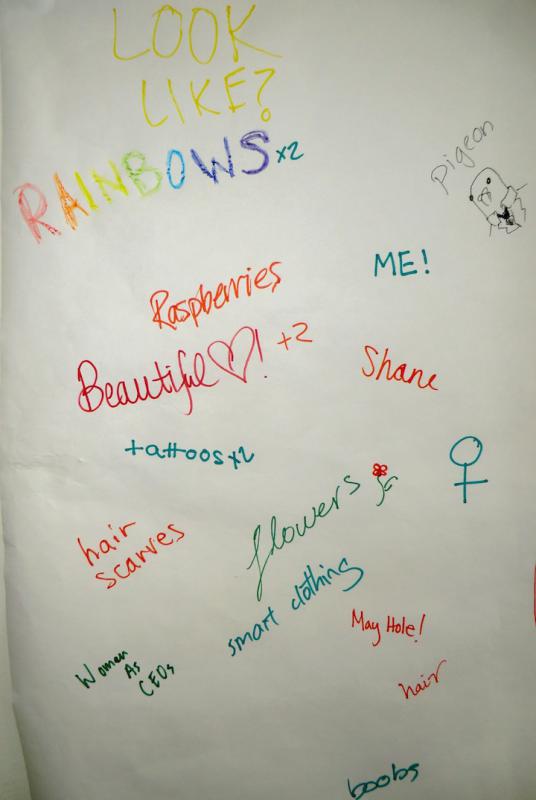

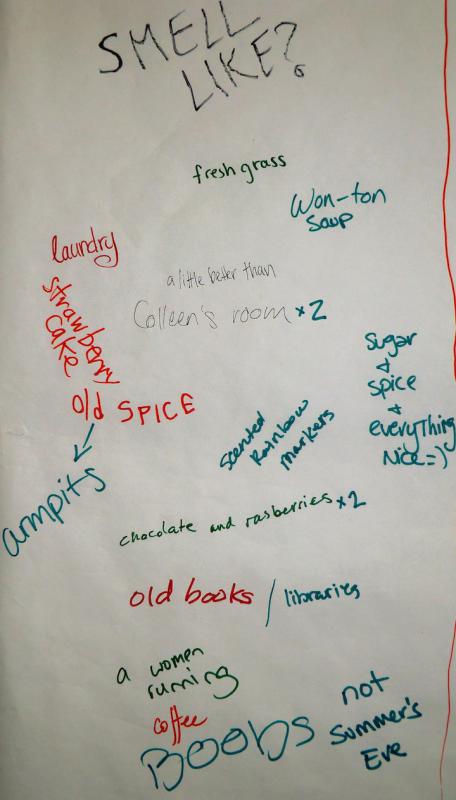
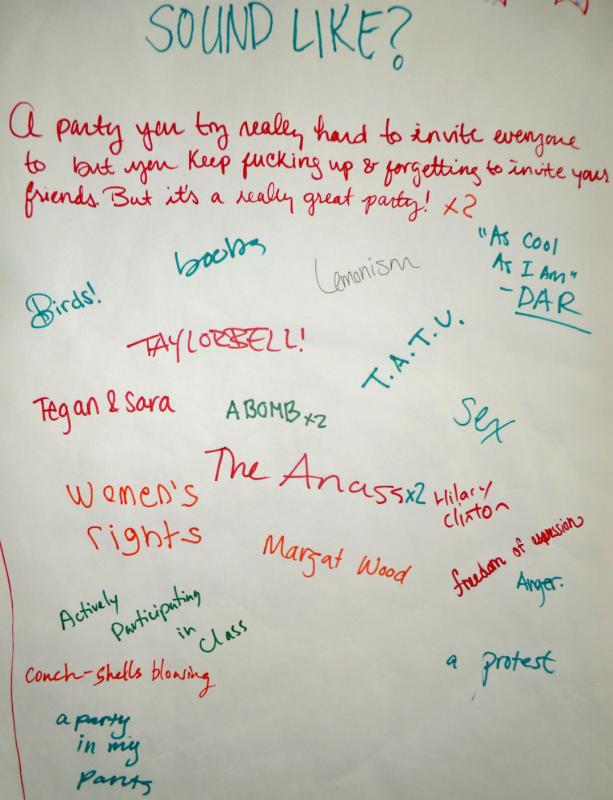
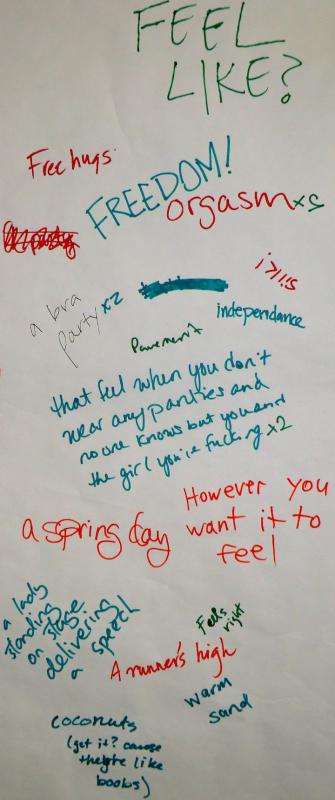
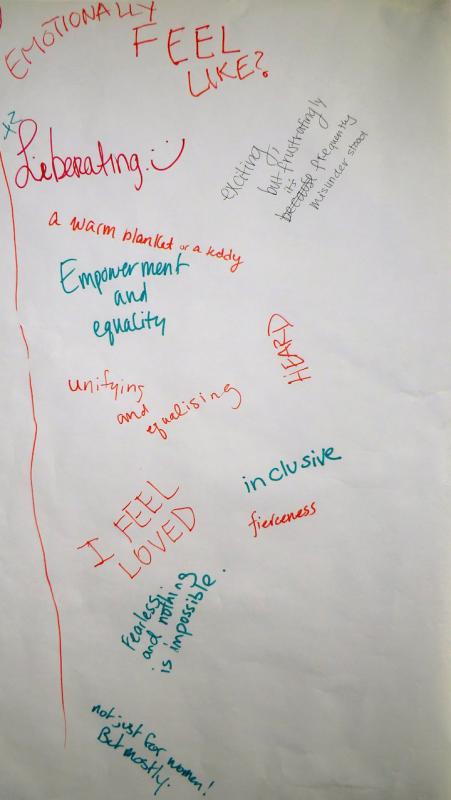
Some of the responses from the facebook event for "sound" were very useful:
The Archetypes - Marina and the Diamonds
Seven Nation Army - The White Stripes
And MC's fabulous collage combining everything under the "looks like" category:
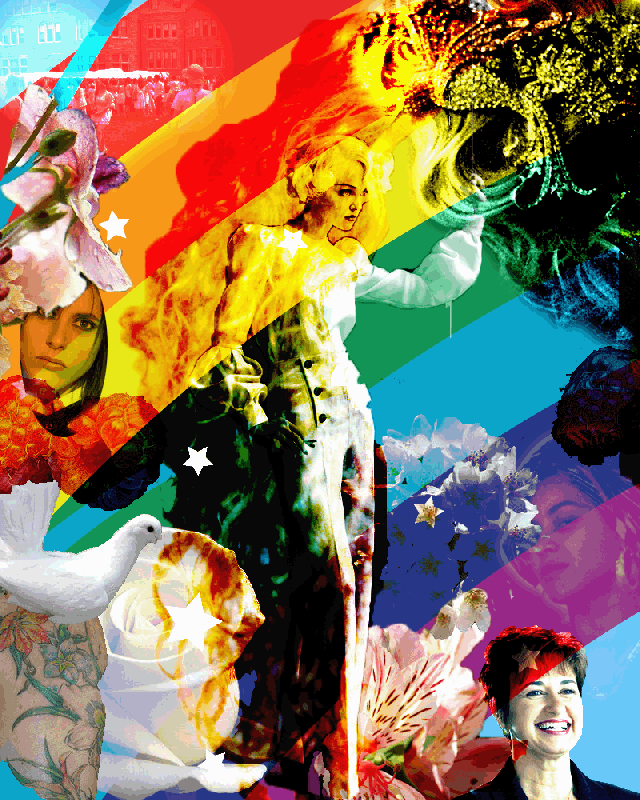
Looking at all the responses, there are a lot of trends that are potentially expected but also interesting to look at. Not surprisingly, a lot of people associate "feminism" strongly with women and queer women especially. Some of the examples given have seemingly nothing to do with "feminism;" some of the responses are solely references to women, especially sexual references (boobs, vagina, sex... ) , or references to queer women (Shane). Also not surprisingly, there are a lot of associations with Bryn Mawr on the board (Anass, Taylor Bell, May Hole, etc.). And of course, since many of the people we surveyed were our friends, we got some jokes ("A little better than Colleen's room," pidgeons...).
One thing that stood out strongly to me, however, was the large amount of fruit imagery. Especially in the "tastes" category, fruit seems to be what people associate feminism most strongly with. Why is that? Is it because fruit is 'feminine'? Because of the shape of the fruit, or the taste of the fruit? One of the many people who responded with "strawberries" for the taste category explained that strawberries are strongly associated with May Day for her, and therefore very feminist (therefore another Bryn Mawr reference).
Finally, during the teach in, we brought in some of the food listed, some of the smells, the collage, and played the music in the background of the presentation. We invited everyone in the class to partake of the food while reading and responding to the responses we gathered. A few people wrote on the board themselves, but most commented on the answers and ate the food. Was it useful to experience feminism the way your peers do? Were any of the responses surprising? Do you have any better ideas about what feminism _____ like?



Comments
What does feminism think like?
I have no idea why that picture turned out so grainy, when I bring it up on my computer it looks fine. Ah well.
This entire semester I have been exploring what it means to communicate with non-traditional media, especially as a platform for studying and discussing feminist thought. Our class discussions on taste were especially intriguing to me, as before this I had often limited my explorations to visual, aural, and oral media. The difficulties I had trying to verbally communicate the specific taste of salt during one of our classes were very frustrating, and were actually reflective of struggles I have been having all semester in articulating my ideas on feminism. Where I could easily visualize my feelings, I couldn't produce words, or at least words that made very much sense. This project offered me the opportunity to continue dissecting my own inability to verbalize my thoughts, as well as give a look into how the minds of our peers functioned, and how they processed concepts.
I was in part pleased and frustrated by the people who gave their answers incredibly careful thought. On the one hand, that they were processing their reactions and developing their ideas was very good, but on the other I was very interested in seeing and analyzing people's visceral reactions to our questions.There were still some very interesting trends to be found among the answers, though. As Colleen Ryanne has stated, the majority of respondents definitely had a strong mental connection of feminism to women, especially symbolic and physical representations of women, as well as a connection to Bryn Mawr. Bryn Mawr as a community prides itself on being relatively feminist and open (the extent of this is open for interpretation), and for many students I know their interest in feminism was kindled since coming to Bryn Mawr, so this connection is not very surprising to me. The multitude of (overwhelmingly bioilogically symbolic) women-related answers also isn't surprising to me, as we have mentioned in previous classes that the main stream media (and certain ongoing and past movements) presents feminism as a movement only directly relevant to women, and as such those who are interested in feminism are women. I think many of the Bryn Mawr-centric responses could also be interpreted as responses to mainstream presentations of feminism, as the examples given were very community-specific and a community fueled/inspired by feminism that is a community in the sense of not only living together and participating in discussions but also feeling interconnected and supported is rarely a vision of a feminist community or community largely comprised of women as presented by mainstream media (girl hate as far as the eye can see).
Even though I've been heavily engaged with visual and aural media all semester, I think I was most intrigued to find out people's responses to the taste and smell questions, especially considering how closely taste and smell as processes are linked in the body. The only overlap we saw between the two, however, was at chocolate and raspberries, which I found surprising and maybe the tiniest bit disappointing, as I admit I was hoping to see some really strong connections between the two. It might have partly been because of our sample: the pool was relatively small, and most of the people we asked were our friends, who might have given us answers that they thought we wanted. Were we to do this again I would probably set up the station over long periods of time (days) outside the dining halls, and see what the changes in data would be.